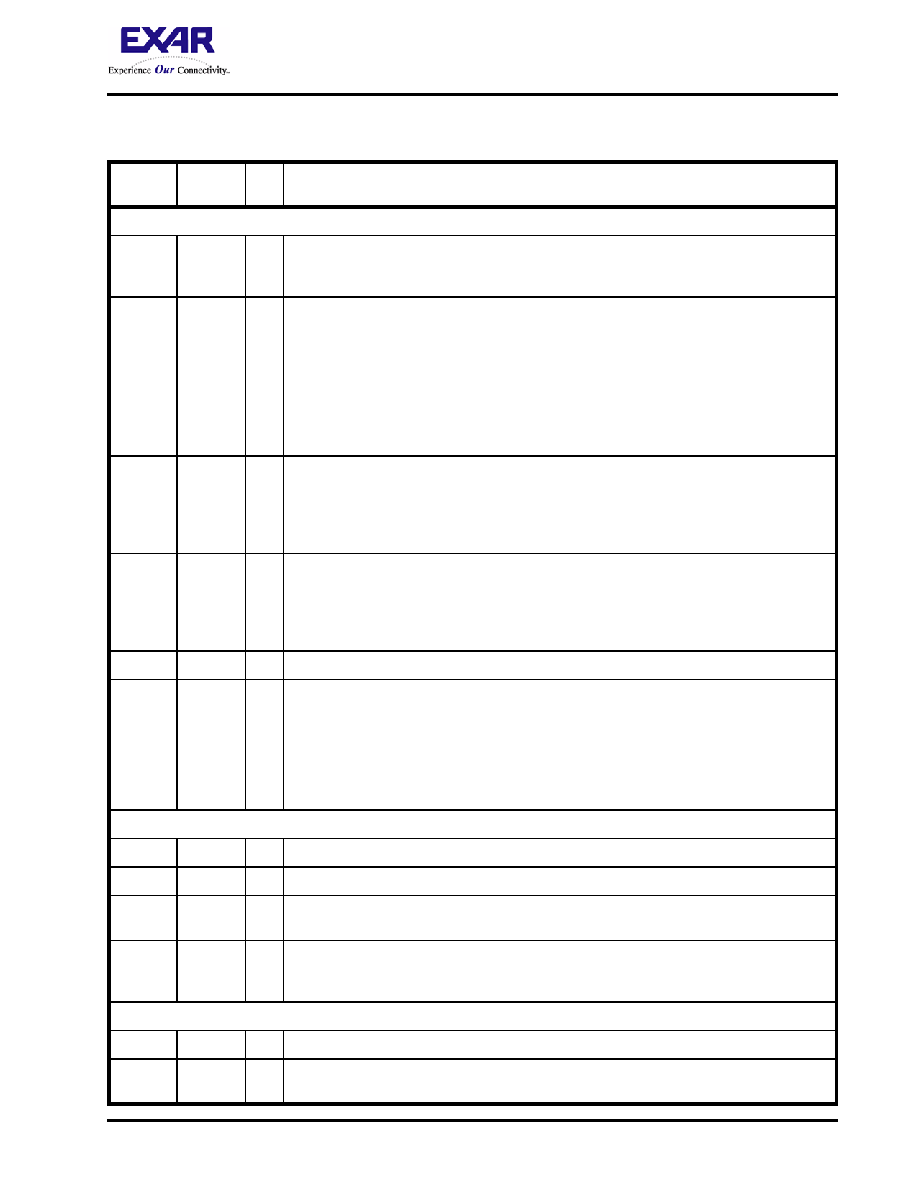- 您現(xiàn)在的位置:買賣IC網(wǎng) > PDF目錄16512 > XR19L210IL40-0B-EB (Exar Corporation)EVAL BOARD FOR XR19L202 40QFN PDF資料下載
參數(shù)資料
| 型號: | XR19L210IL40-0B-EB |
| 廠商: | Exar Corporation |
| 文件頁數(shù): | 23/43頁 |
| 文件大?。?/td> | 0K |
| 描述: | EVAL BOARD FOR XR19L202 40QFN |
| 標準包裝: | 1 |
| 系列: | * |
第1頁第2頁第3頁第4頁第5頁第6頁第7頁第8頁第9頁第10頁第11頁第12頁第13頁第14頁第15頁第16頁第17頁第18頁第19頁第20頁第21頁第22頁當前第23頁第24頁第25頁第26頁第27頁第28頁第29頁第30頁第31頁第32頁第33頁第34頁第35頁第36頁第37頁第38頁第39頁第40頁第41頁第42頁第43頁

XR19L210
3
REV. 1.0.2
SINGLE CHANNEL INTEGRATED UART AND RS-232 TRANSCEIVER
PIN DESCRIPTIONS
Pin Descriptions
NAME
40-QFN
PIN#
TYPE
DESCRIPTION
DATA BUS INTERFACE (CMOS/TTL Voltage Levels)
A2
A1
A0
23
24
25
I
Address bus lines [2:0]. These 3 address lines select one of the internal registers in the
UART during a data bus transaction.
D7
D6
D5
D4
D3
D2
D1
D0
8
7
5
38
37
36
35
34
I/O
Data bus lines [7:0] (bidirectional).
IOR#
(NC)
19
I
When I/M# pin is HIGH, the Intel bus interface is selected and this input becomes read
strobe (active LOW). The falling edge instigates an internal read cycle and retrieves the
data byte from an internal register pointed by the address lines [A2:A0], puts the data byte
on the data bus to allow the host processor to read it on the rising edge.
When I/M# pin is LOW, the Motorola bus interface is selected and this input is not used.
IOW#
(R/W#)
17
I
When I/M# pin is HIGH, it selects Intel bus interface and this input becomes write strobe
(active LOW). The falling edge instigates the internal write cycle and the rising edge trans-
fers the data byte on the data bus to an internal register pointed by the address lines.
When I/M# pin is LOW, the Motorola bus interface is selected and this input becomes read
(HIGH) and write (LOW) signal.
CS#
9
I
This input is chip select (active LOW) to enable the device.
INT
(IRQ#)
26
O
(OD)
When I/M# pin is HIGH, it selects Intel bus interface and this output become the active
HIGH device interrupt output. This output is enabled through the software setting of MCR[3]:
set to the active mode when MCR[3] is set to a logic 1, and set to the three state mode when
MCR[3] is set to a logic 0. See MCR[3].
When I/M# pin is LOW, it selects Motorola bus interface and this output becomes the active
LOW, open-drain interrupt output. An external pull-up resistor is required for proper opera-
tion. MCR[3] must be set to a logic 0 for proper operation of the interrupt.
MODEM OR SERIAL I/O INTERFACE (EIA-232/RS-232 Voltage Levels)
TXD
10
O
UART Transmit Data. The TX signal will be LOW (< -5V) during reset or idle (no data).
RXD
2
I
UART Receive Data. The RX data input must idle LOW (< -3V).
RTS
11
O
UART Request-to-Send or general purpose output. This output must be asserted prior to
using auto RTS flow control, see EFR[6], MCR[1] and IER[6].
CTS
1
I
UART Clear-to-Send or general purpose input. It can be used for auto CTS flow control,
see EFR[7], MSR[4] and IER[7]. This input has an internal pull-down resistor and can be left
unconnected when not used.
ANCILLARY SIGNALS (CMOS/TTL Voltage Levels)
XTAL1
14
I
Crystal or external clock input. This input is not 5V tolerant.
XTAL2
15
O
Crystal or buffered clock output. This output may be use to drive a clock buffer which can
drive other device(s).
相關(guān)PDF資料 |
PDF描述 |
|---|---|
| VI-252-EX | CONVERTER MOD DC/DC 15V 75W |
| 5504972-4 | CABLE ASSEM FIBER SC-ST 5 METER |
| ILSB1206ER6R8K | INDUCTOR 6.8UH 10% 1206 |
| EBC31DRTS-S13 | CONN EDGECARD 62POS .100 EXTEND |
| ILSB1206ER68NM | INDUCTOR 0.068UH 20% 1206 |
相關(guān)代理商/技術(shù)參數(shù) |
參數(shù)描述 |
|---|---|
| XR19L210IL40-F | 功能描述:UART 接口集成電路 UART RoHS:否 制造商:Texas Instruments 通道數(shù)量:2 數(shù)據(jù)速率:3 Mbps 電源電壓-最大:3.6 V 電源電壓-最小:2.7 V 電源電流:20 mA 最大工作溫度:+ 85 C 最小工作溫度:- 40 C 封裝 / 箱體:LQFP-48 封裝:Reel |
| XR19L212 | 制造商:EXAR 制造商全稱:EXAR 功能描述:TWO CHANNEL INTEGRATED UART AND RS-232 TRANSCEIVER |
| XR19L212IL48 | 制造商:EXAR 制造商全稱:EXAR 功能描述:TWO CHANNEL INTEGRATED UART AND RS-232 TRANSCEIVER |
| XR19L212IL48-0B-EB | 功能描述:界面開發(fā)工具 Supports L212 48 pin QFN, PCI Interface RoHS:否 制造商:Bourns 產(chǎn)品:Evaluation Boards 類型:RS-485 工具用于評估:ADM3485E 接口類型:RS-485 工作電源電壓:3.3 V |
| XR19L212IL48-F | 功能描述:UART 接口集成電路 UART RoHS:否 制造商:Texas Instruments 通道數(shù)量:2 數(shù)據(jù)速率:3 Mbps 電源電壓-最大:3.6 V 電源電壓-最小:2.7 V 電源電流:20 mA 最大工作溫度:+ 85 C 最小工作溫度:- 40 C 封裝 / 箱體:LQFP-48 封裝:Reel |
發(fā)布緊急采購,3分鐘左右您將得到回復。